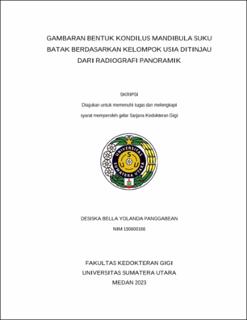Gambaran Bentuk Kondilus Mandibula Suku Batak Berdasarkan Kelompok Usia Ditinjau dari Radiografi Panoramik

Date
2023Author
Panggabean, Desiska Bella Yolanda
Advisor(s)
Sitanggang, Maria Novita Helen
Metadata
Show full item recordAbstract
The mandibular condyle has a variety of shapes and sizes that are influenced by age, sex, malocclusion, and skeletal. This study aims to determine the prevalence of the mandibular condyle shape in the Batak ethnic group based on age in panoramic radiography. This type of research is descriptive with the sampling technique using the purposive sampling method. A total sample of 120 panoramic radiographs was grouped into six age groups (6-12; 13-18; 19-24; 25-35; 36-45; and 36-60 years), each comprising 20 samples. The results showed that the round condyle shape had the highest percentage, including groups 1 (70%, right; 65%, left), 2 (65%;70%), 3 (55%;45%), 4 (65%;55%), 5 (45%;35%), 6 (round 45%, right; round and angled 35%, left). The shapes found were low in each group, namely 1 (crooked finger 0%), 5 (crooked finger 10%), 2 (pointed and crooked fingers 10% each (right); angled 5% (left)), 3 (angled 10% (right); angled 5%(left)), 4 (pointed 5% (right); angled 5% (left)), 6 (crooked finger 10%(right); pointed and crooked fingers 15% each (left)). This study concludes that the most common form of condyle found in the Batak tribe is round, which was obtained in groups 1 and 2 (67.5% each), 3 (50%), 4 (60%), 5 and 6 (40%), and condyles with low percentages in groups 1, 5 and 6 respectively crooked fingers, 0%, 10% and 12.5%, followed by groups 2 and 4 with angled and pointed shapes 10%, and group 3 angled 7.5%.
Collections
- Undergraduate Theses [1901]
